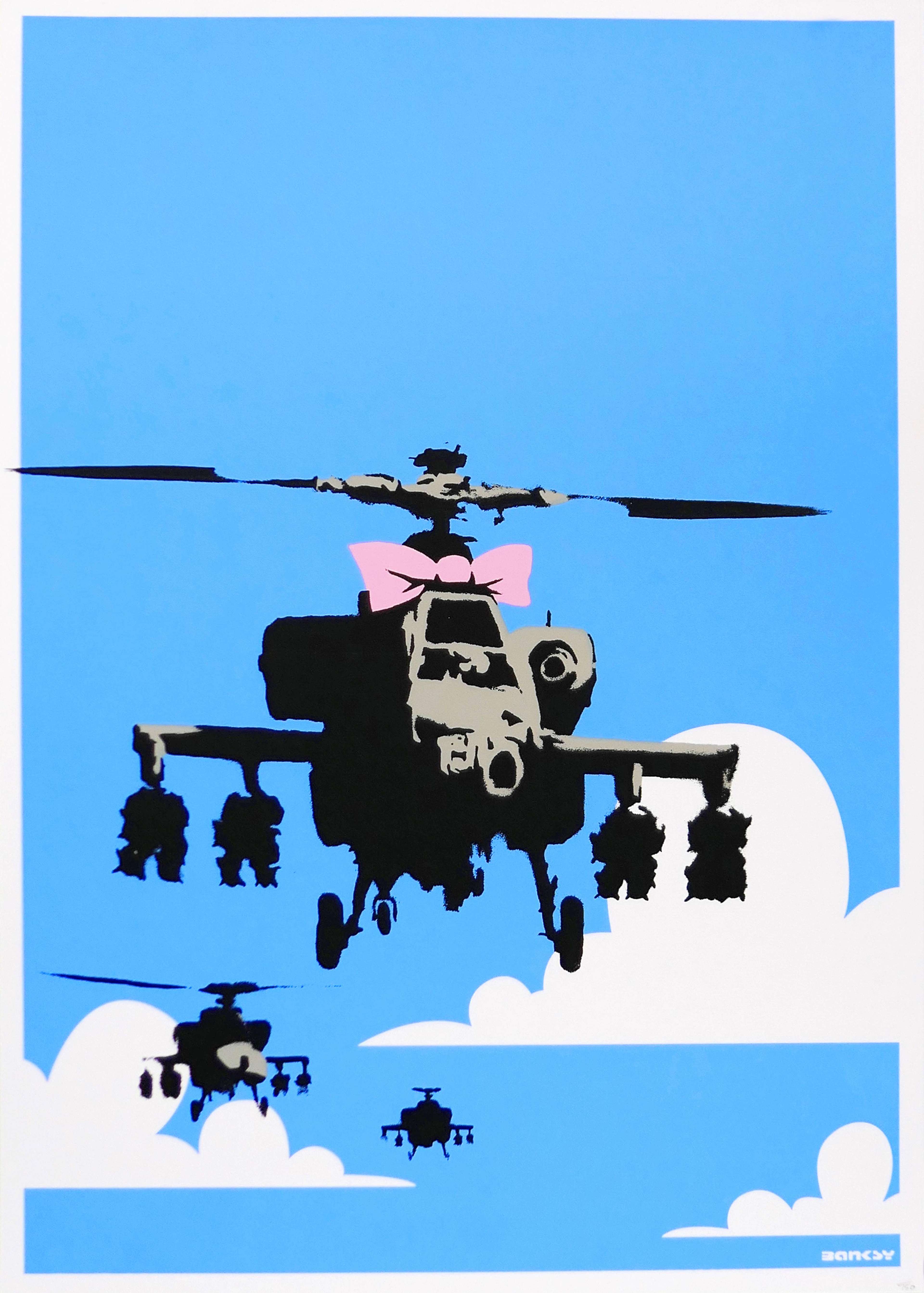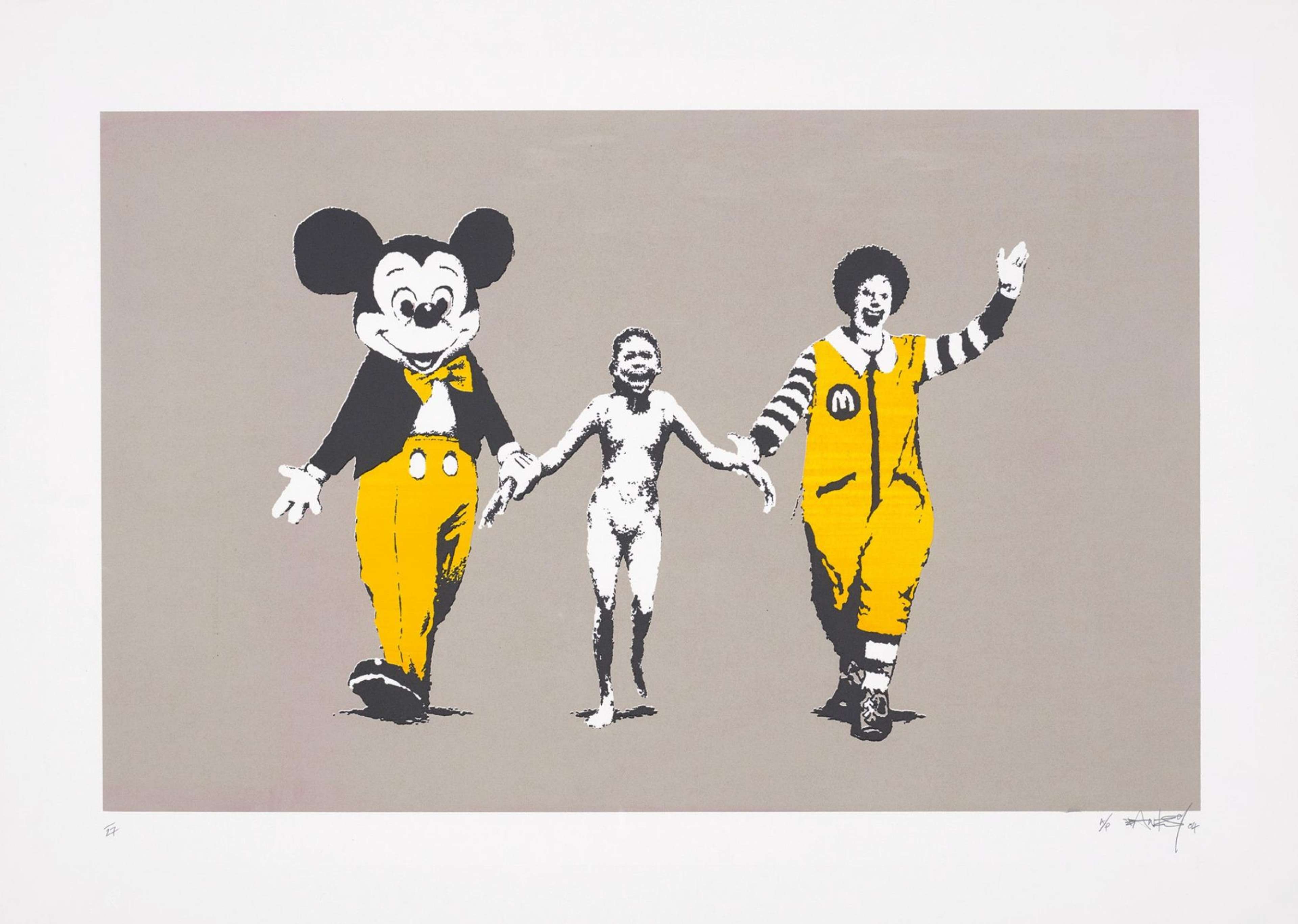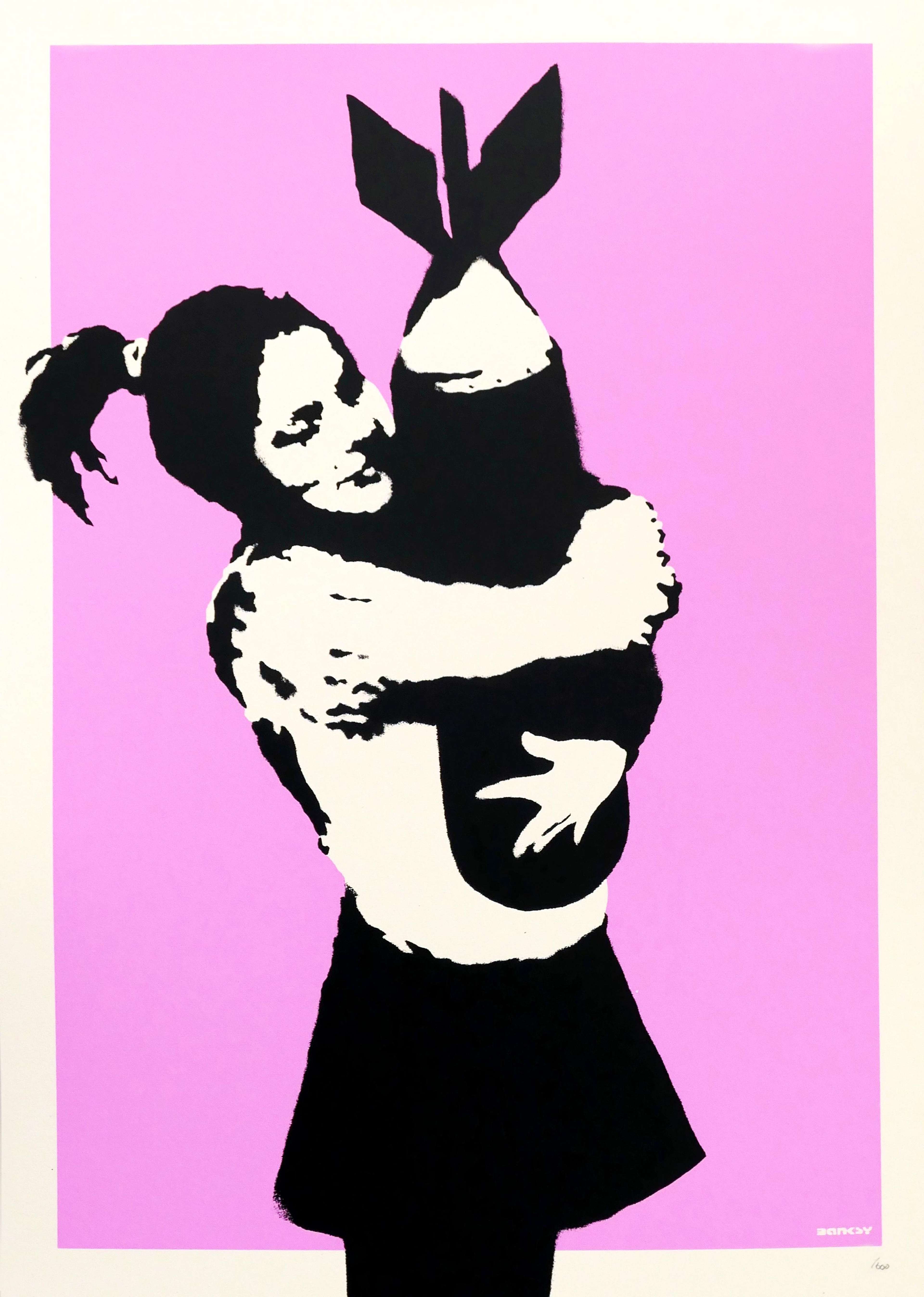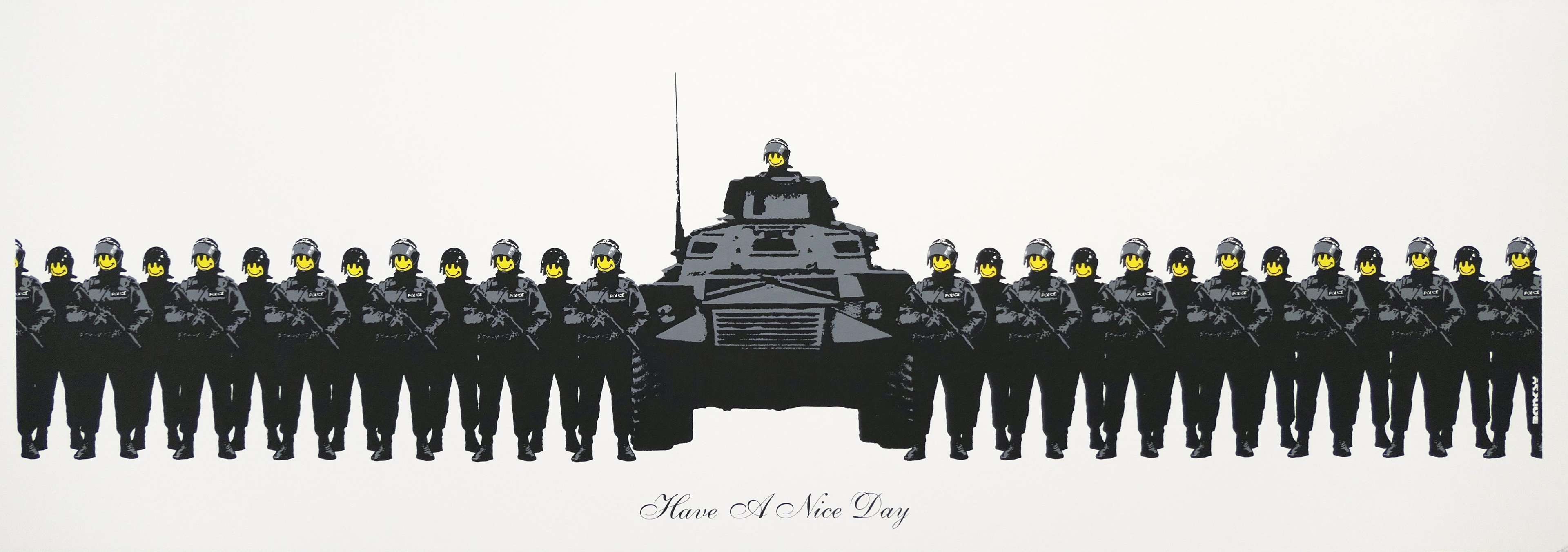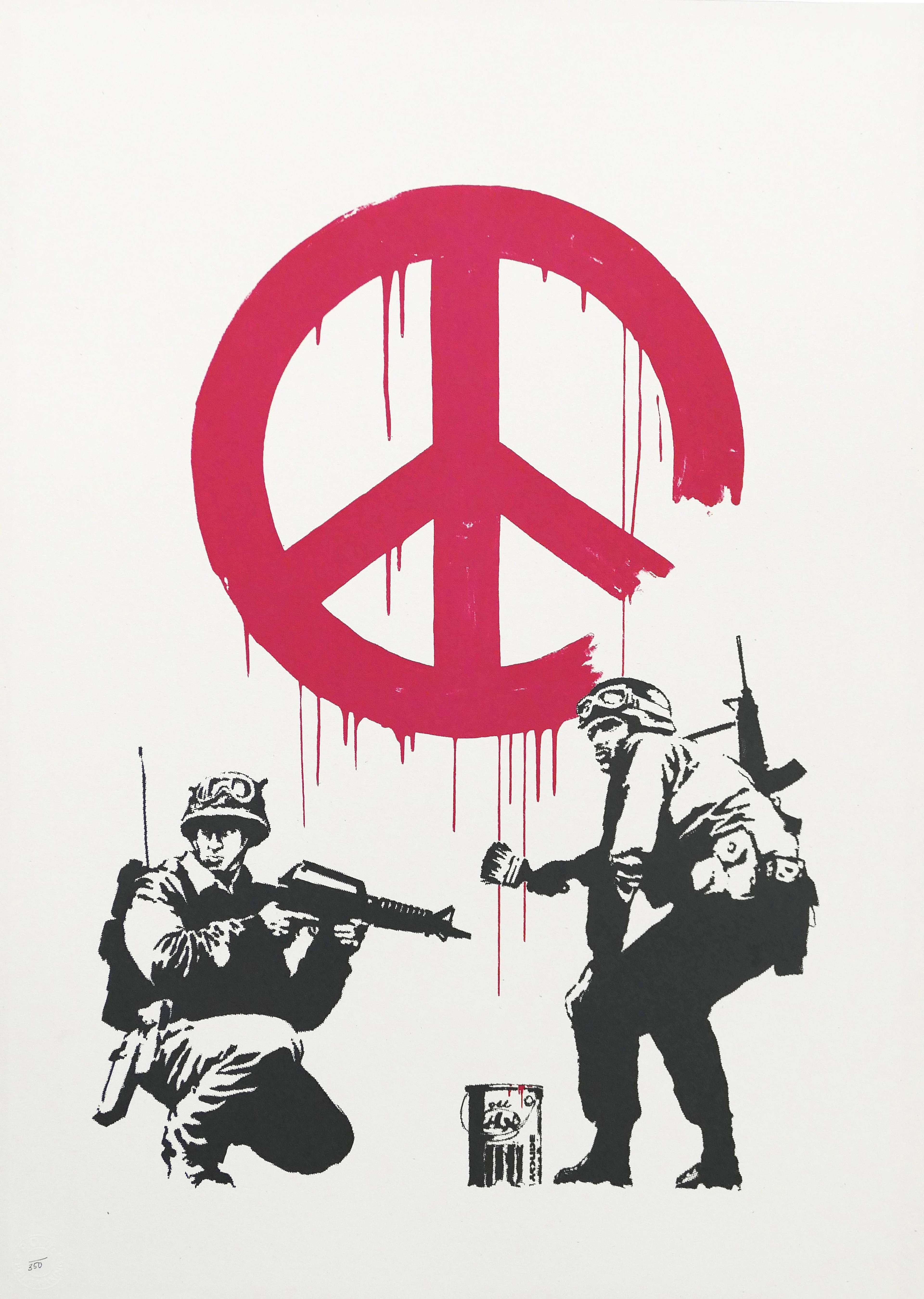 CND Soldiers © Banksy 2005
CND Soldiers © Banksy 2005
Banksy
269 works
Banksy has long used his art to speak against war, injustice, and the failures of power. His work often appears when public attention is most needed – offering sharp, visual interventions that cut through noise and challenge complacency. In recent years, two standout moments have once again placed Banksy at the centre of political commentary.
2025: Royal Courts of Justice Mural
On 8 September 2025, Banksy revealed a mural on the walls of the Royal Courts of Justice in London, showing a judge raising a gavel toward a protestor holding a placard. Above them, a surveillance camera is positioned but conspicuously turned away from the confrontation. The piece appeared on Banksy’s Instagram with a rare and unusually explicit caption: “. Royal Courts of Justice, London.”
The timing of the mural – just days after the reported arrest of over 900 pro-Palestinian protesters across the UK, and shortly after the Royal Courts’ decision to reject an appeal by Palestine Action – has sparked widespread interpretation. While the work makes no explicit reference to these events, the choice of site, the institutional symbolism, and the visual language of protest and power all suggest a deeper critique. The mural was quickly covered within 48 hours of appearing. As ever, Banksy’s silence – and the system’s response – speak volumes.
2024: Glastonbury Migrant Boat Performance
A year earlier, in 2024, Banksy staged a surprise intervention at Glastonbury Festival during IDLES’ headline set. He sent an inflatable lifeboat filled with dummies dressed in life jackets into the crowd – a haunting reference to the ongoing migrant crisis and the perilous sea journeys made by displaced people. The performance echoed Banksy’s earlier activism, including his funding of the M.V. Louise Michel, a rescue vessel operating in the Mediterranean.
Both the timing and the imagery reinforced a pattern in Banksy’s recent works: a move from static protest to participatory disruption – using live events and institutional architecture to frame questions of accountability, complicity, and visibility.
Banksy’s Career-Long Resistance to War
Banksy has used art as a weapon against war throughout his entire career and is one of the most politically active artists working today. Known for his unapologetic criticism of today’s political, military and financial establishments, Banksy expresses this through his iconic, but ever-pertinent imagery.
A crucial pillar of Banksy’s activism is his stance against all forms of war and violence. Just look to his print CND Soldiers, depicting two soldiers dressed in full combat gear painting a bright red peace sign onto a wall; or Turf War, a tongue-in-cheek portrait of Winston Churchill rocking a bright green mohawk; and Napalm, where he inserts the figure of a crying child from an original photograph taken during the Vietnam War between a cheerful Mickey Mouse and Ronald McDonald.
These powerful anti-war images have perhaps never been more relevant, gaining newfound importance in the light of the Putin-led invasion of Ukraine and resulting refugee crisis. We take a closer look here at Banksy’s critical politics, how they’re expressed in his work and where his practice sits within the context of anti-war art.
Street Art & Activism
Street Art has always been a politically charged art form, allowing artists to express their beliefs in a democratic, public setting. Working with stencil since the 1990s, Banksy has always used public space to convey his hard-hitting activist messages. He works within a street art tradition made popular by the likes of Keith Haring, who also has a body of important anti-war works responding to the Iraq war in 1984, as well as to nuclear weapons during the Cold War. Street Art continues to serve this function in the present day, through the work of Banksy and his contemporaries like American artist Shepard Fairey, whose reimagined propaganda style posters convey his anti-war stance and dedication to fighting for peace.
What are Banksy's Political Beliefs? What is Banksy Against?
Banksy’s art gives voice to the interests and concerns of the “masses'' versus the powerful few. Political elites are a common subject of mockery in his work. We see this in the punk makeovers given to legendary wartime prime ministers or in the controversial primate portrait of Queen Elizabeth in Monkey Queen, where the British monarch is depicted as a monkey with a crown.
Banksy’s political views are anti-capitalist, anti-religion and anti-war, expressed with a clever twist. His artworks often highlight the connections between these three dominant establishments, such as in the works Happy Choppers, Golf Sale and Have a Nice Day, which all point to the overlaps between global capitalism and the military-industrialist complex.
The message to protest inequality, violence, oppression and war resonates loud and clear throughout Banksy’s work.
Anti-War Symbolism in Banksy's Work
There are two elements to Banksy’s successful criticism here; potent symbolism, and clever juxtaposition. Universal symbols for peace are often seen in contrast with violent, menacing figures or actions, such as the bouquet of flowers in Flower Thrower or the peace sign in CND Soldiers. In the print Bomb Love, a young girl clutches a missile to her chest like a present and in Happy Choppers, ominous military helicopters are wrapped in pink bows against a baby-blue sky.
Children are also repeatedly used as symbols of hope and innocence, depicted in juxtaposition to the horrors of war and violence - the limited edition print Kids on Guns being another example of Banksy’s abilities to manipulate our expectations and prod our emotional receptors when it comes to our experiences of war.
The acid yellow smiley face is another image that appears in several works. The anti-war artwork Have a Nice Day shows a row of armed soldiers with eerie yellow smiley faces to a deeply unsettling effect. Far from the 90s rave scene one would expect to see alongside this motif, we are instead confronted with an advancing military, where the threat of impending violence is palpable. Banksy is a master of combining anachronistic visual elements, gripping the viewer’s attention and undermining commercial associations to drive his message home.
Banksy's Activism
Banksy has raised funds for charitable causes on many occasions, proving that his beliefs are more than skin deep and that art in practice can indeed make a change. In 2017, the artist donated three oil paintings that drew attention to the European migrant crisis to raise money for a hospital in Bethlehem. Mediterranean Sea View 2017, as a tryptic sold for £2.23 million at Sotheby’s with all proceeds going to Bethlehem Arab Society for Rehabilitation.
In a 2019 project that strikes as especially relevant today with the increasing number of Ukrainian refugees forced to flee their homes, Banksy designed door mats to be hand-stitched by women in Greek refugee camps from life-vests found on the local beach. This project provided this group of women with employable skills and wages. The profits from the editions went towards supporting the camp’s infrastructure and the creation of further jobs.
Banksy's Legacy: Anti-War Street Art Today
Banksy’s mission to confront a global audience with the realities of war and advocate for peace hits a particularly poignant note today within the context of Russia’s invasion of Ukraine.
CND Soldiers seems particularly relevant when we consider how Banksy’s anti-war works speak to universal crises: its conception stems specifically from opposition to Britain’s involvement in the war with Iraq and the hope for nuclear disarmament. This image raises questions that remain applicable to any anti-conflict context. The fact that the protestor here is a soldier himself begs the question of who we place our faith in when it comes to warfare, and who the real villains are in terms of authority and decision making. It's hard not to think of the anti-war protests going on within Russia itself, as well as the more obvious freedom fighting taking place within Ukraine.
In the communal spirit of street art, Banksy has inspired other local artists to express their politics through their art. The so-called “Ukrainian Banksy”, a street artist by the name of Sharik, created a number of artworks in 2011 on the streets of Crimea in a stencilled style inspired by Banksy. Other artists across the UK have taken to the streets to express solidarity with the Ukrainian people over the past weeks. This includes the “Teesside Banksy” of Middlesbrough and the numerous anti-war graffiti works that have popped up in Russian cities. This only goes to show Banksy’s pervasive influence on street art and its politics, galvanising artists and civilians around the world to speak out against war and demand peace.
 Mural in Borodyanka, Ukraine © Banksy 2022
Mural in Borodyanka, Ukraine © Banksy 2022Banksy's Anti-War Stance in Ukraine
In the case of Putin's illegal invasion of Ukraine, Banksy's style of subversive humour, combined with seriously pertinent and emotive imagery, has already proven its capacity to provide solace. The new artworks across Ukraine, including in Borodyanka and Kyiv, have captured the mood in Ukraine and around the world—while full of condemnation for the effect the invasion has had on ordinary civilian lives, the overall mesage remains one of hope and admiration for Ukraine's national strength—as Banksy joins in condemning Putin's war.
Banksy’s powerful symbolic language gains extraordinary potency during such difficult times. His art and activism continues to inspire and give hope to people around the world, reminding us of our shared responsibility and humanity.
Read more about the new murals in Ukraine and the initial speculation over whether they were created by Banksy in our article here.
 The Walled Off Hotel © 2024
The Walled Off Hotel © 2024The Walled Off Hotel in Bethlehem
In 2017, the centenary of Britain's assumption of control of Palestine, Banksy opened his Walled Off Hotel. In Banksy's words, the hotel offers “the worst view in the world” of the Israeli West Bank Wall and offers a shrewd critique of the atrocities faced by Palestinian citizens. More poignant than ever, the Walled Off Hotel closed its doors in October 2023 following the events of October 7th. The official Walled Off Hotel website contains the following statement on its landing page:
“Due to major developments in the region we have with regret chosen to close the hotel for the time being. We will not be taking reservations at the current time.
We will post updates here as the situation evolves. Thank you for your custom and we look forward to welcoming you again soon.”
Over a year on, the “situation” shows no sign of being resolved. The hotel was one of the subjects of Walled Off earlier in 2024, a documentary showcasing “Palestinians' fight for freedom through creative resistance,” co-produced by Anwar Hadid.

